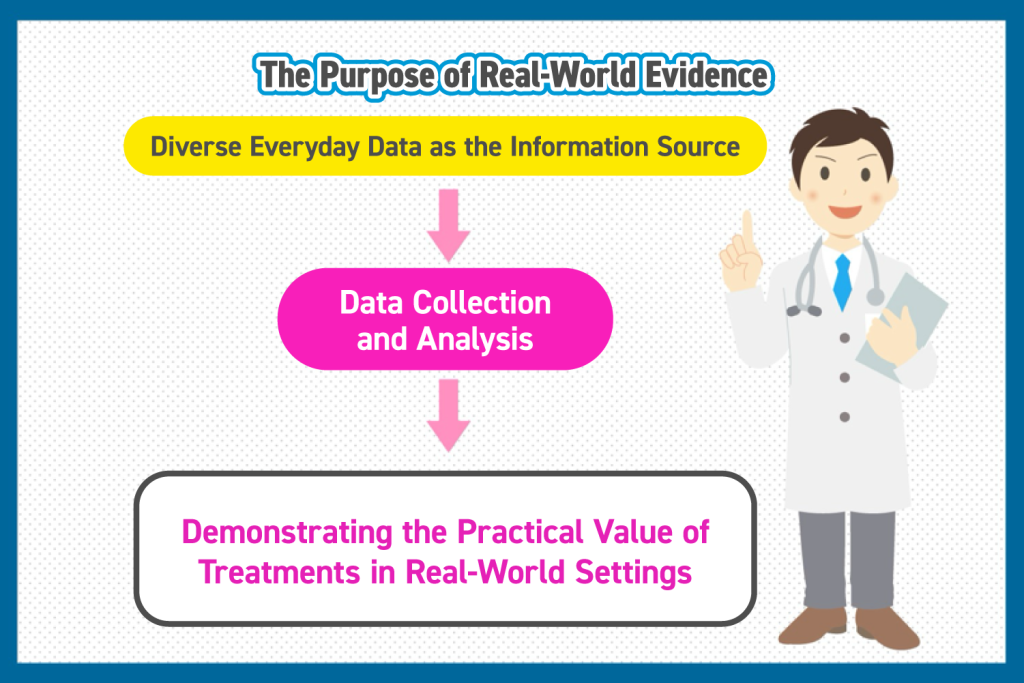In recent years, real-world evidence (RWE) has been a great focus in the healthcare industry. RWE can assist healthcare professionals in evaluating treatment plans or the efficacy of a product by combining different information.
This article will help explore RWE in terms of the purpose, current situation and further expectation, along with the difference with clinical trials.
What is Real-World Evidence (RWE)?
RWE is clinical evidence derived from various information sources, relating to the use of pharmaceuticals and their anticipated benefits and risks. RWE is obtained by analyzing real-world data (RWD) of patients’ health conditions and the healthcare they receive, which consists of everyday data collected from various sources.
Real-World Data is wide-ranging and includes the following examples:
- Electronic medical records
- DPC data
- Claims data
- Patient registries
- Health checkup data
- Data obtained from wearable devices, etc.
Differences between RWE and Clinical Trials
RWE and clinical data are often confused. Clinical trial data is obtained from carefully planned studies conducted on a target cohort. Such data is highly reliable and accurate because it follows specific protocols for research and verification purposes. On the other hand, RWE is sourced from everyday data collected from a large, random population. Since RWE includes not only patient data but also various background information, it can be used for a wide range of applications beyond research and verification.
Based on the purpose, the use of RWE and clinical data may differ.
The Purpose of RWE

The main purpose of RWE is to demonstrate the practical value of treatments in real-world settings
Randomized Controlled Trial (RCT) plays a role in the evaluation of pharmaceuticals and treatments in the healthcare industry by conducting study with randomized participants. Although this method allows to determine whether a pharmaceutical or treatment is effective, kids, the elderly, and those with multiple diseases are not always included, resulting in less representation in daily medical practice, where patients come from diverse backgrounds.
RWE collects and analyzes everyday data from all populations, including those not included in RCTs, enabling more realistic verification of treatment evaluation. In this way, RWE acts as a complement to RCTs.
Current Status of RWE
Following the United States’ lead, research on RWE is gaining momentum in Japan as well. However, there are many tasks to leverage practical utilization of RWE, such as transparent analysis methods and framework, guidelines for using RWE in approval applications, not to mention the scale of data and data linkage.
Differences from RWD
RWD and RWE are closely related, yet not completely the same. RWD is big data obtained from routine healthcare and hospital records, while RWE is the result derived from the analysis of this data. In other words, RWD serves as the source and foundation of RWE. To obtain more useful RWE, a wealth of RWD and appropriate analytical methods will be crucial.
Expectations for RWE
RWE is expected to have the following benefits:
- Improved efficiency of diagnosis and treatment by physicians
- Detection of risks associated with the use of pharmaceuticals and medical devices
- Enhanced quality of health management and preventive medicine
- Streamlined process for clinical development and applications for drug approval
- Enhanced quality of nursing care services
- Evaluation of healthcare policies and implementation of measures by the government
RWE, derived from collecting and analyzing various types of data, is believed to contribute to improving the quality of life (QoL) for the general public and patients who provide the data. Additionally, using RWE to evaluate new pharmaceuticals and medical devices may help assess their efficacy and detect risks at an early stage, resulting in the facilitation of the progress of clinical development and approval applications. In fact, in Europe and the United States, RWE is increasingly being used for obtaining the approval of clinical development, insurance reimbursement, price negotiations. Although the RWE is gaining attention gradually in Japan, its integration into healthcare settings is expected to accelerate alongside the development of legislation and guidelines.
RWE Plays a Role in Improving QoL
RWE refers to evidence obtained by collecting and analyzing a wide range of healthcare information. The use of evidence derived from diverse data can help evaluate new pharmaceuticals, medical devices, and treatments, as well as facilitate clinical development and approval applications. Given the improvement in the quality of health management and preventive healthcare as examples, RWE, which is based on vast amounts of everyday data, can be applied in various ways, resulting in high expectations for its contributions.




